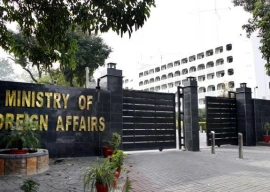
Being a Karachiite, one can vouch for the impression that evenings in the city hit a different note with the sea breeze coming in; there is calmness in the air, and overall good weather conditions. No matter how hot the day gets, evenings are breezy. Being a millennial, I can remember wedding functions held in December were in cold weather but have you noticed lately that the onset of Karachi chilly weather is shifting to later months? Can you recall being a kid, when March or April was colder than it is now and November or December was not so cold? In the last three years, the seasonal shift has been evident not just in Karachi but across the country.
Pakistan is in the top 10 countries that are most affected by climate change according to Climate Index and the country is experiencing seasonal shifts or delayed seasons. For instance, winter would usually start in early November but now starts in late December and ends at the end of March. Eventually, the cycle will run its full course; if the season starts late, it will also end late. But it’s not just about completing the cycle of seasons. The delay in seasons is impacting the overall ecosystem. Let’s understand what season delays mean and what damage they can bring in the next few years.
“Season delays are simple to understand. Winters come late and fluctuate while going away as we have seen in the current scenario where, in February, one week it was summer but then the weather changed, it rained and again it was winter till the start of March,” told environmentalist Tofiq Pasha Mooraj, adding that this delayed spring and summer both. “When a season doesn’t start at its normal timing then it affects the crops and the country, which is highly dependent on agriculture, cannot afford that at all,” he explained.
Pakistan has been experiencing a wide range of climates, with scorching summers, chilly winters, and monsoon rains. These weather patterns can suddenly change or become extreme, which can stress crops and cause lower yields or crop failure. “Changing timelines of the seasons and climate change impacts are a pressing concern to be dealt with and have serious and complicated repercussions now: mainly food security,” Mooraj said. Certain seeds require certain temperatures to grow, sprout, and even for harvest but with fluctuating temperatures and changing timelines one cannot predict anything and we can face heavy loss of crops in the coming years.
For instance, Sindh and Punjab have a major mango crop every year which is also exported widely but mango seed sprouts in winter and is harvested in summer. However, given the current scenario of fluctuating temperatures, the sudden shift from winter to summer and then again back to winter during February and March, the seeds can be harmed. “The main problem here is the cycle is not repetitive,” said Mooraj, who grows mangoes on his farm.
“One year, it goes like this and the next year we get a normal cycle or say we don’t get spring at all. In such cases, one cannot predict at all when to plant the seed in what timeline.”
How can the transition of temperature affect crops?
According to Mooraj, in the second week of February this year, the temperature in Hyderabad was 22 degrees and within two days it went up to 36-39 degrees. Such transitions impact agriculture as sudden changes in temperature destroy the seed.
Crops can be harmed by extreme weather, such as heat waves or cold snaps. While cold snaps can result in frost damage and the death of vulnerable crops, heat waves can cause heat stress and dehydration in plants. “We can understand this with one of the largest crops that is wheat. It grows in winters and in summers it dehydrates and gets ready to harvest. But now when the summer comes late, it will not dehydrate on time and cannot be harvested. So how will the demand for wheat be met?” he questioned.
Variations in humidity and temperature can foster an environment that is conducive to the growth of illnesses and pests. Crops can be attacked by fungi, insects, and pathogens, which can result in serious damage if not properly controlled. “When the seasons mix up, we see pests and diseases develop. In summers, pests reproduce and when the crops are not ready to harvest, they will destroy the almost ready crop - which again is a big loss,” Mooraj said.
He stressed that in a country which is already going through inflation, we cannot afford food scarcity. “We have seen crops getting destroyed in the floods of 2022 when we had to import onions and tomatoes, which cost a lot to the country’s economic situation.”
Abnormal weather patterns such as longer summers or shorter winters are not just the two seasons that are impacting agriculture but untimely rains, changing rain patterns and the amount of rainfall also adds to the problem. Pakistan did not receive snow at the right time this year, the northern areas had snowfall quite late this year which will result in water scarcity. “We have no mechanism to store rainwater so we just rely on dams that fill from snow melting and eventually with less snow we have a big issue at hand,” the environmentalist lamented.
The term “climate change” is slightly new as until 20 years back the term in use was “global warming”. After a severe change in global climate, it was understood that global warming isn’t the only effect, the world is facing a whole change of climate. “Anything that will happen out of the fixed season will bring disturbance, be it rain, winter or summer, be it coming early or coming later, everything will impact on a larger scale,” said environmentalist Waqar Ahmed.
A slight change in any weather cycle has great impact. An easy way to understand this is that every crop has a season to grow just as animals have breeding seasons, and birds migrate too depending upon seasons. Changes in temperatures disrupt an ecosystem as a whole. “We have not seen heat and cold waves so often in our lives as we have been experiencing in recent years,” Ahmed said. “The overall condition of Sindh and Balochistan, if we see extreme weather conditions, is evident in recent times with storms and floods.”
Two major things can be done to make the situation better: first is mitigation and second is adaptation. “Mitigation is lessened carbon emission, planting more forests trying to bring alternate energies to help in preventing climate change. Adaptation means planting low water crops and increasing energy efficiency,” he suggested. Energy efficiency can be gained by making energy-efficient homes which can stay temperature-controlled and do not require air conditioners, concrete houses that are already constructed can use materials to cover terraces to prevent heat and also use light colours on walls to help to keep the interior cool. “To make new homes one can use fiber, wood, and other such materials that are used across the world but all these are long-term planning,” Ahmed shared.
Pakistan has a water shortage, particularly in the arid seasons. Drought stress brought on by insufficient irrigation water can hinder crop development and output. “Being an agriculturally dependent country, we need to focus on growing crops that do not require more water while the major crops we grow are mostly those found in tropical countries such as banana, rice, mango, sugarcane, and all other water-intensive crops,” he said. Thus the country is wasting its land as we have no water and such decisions are only causing harm to delta and marine life.
Pakistan lacks basic policies for crop growing. There is a ministry under the name of climate change that has been making some efforts but majority of the impacts are still untouched.
“We need to modify crop patterns and incorporate every industry, and the whole setup in the climate change issues because growing low water crops can save water and can help in storing more food,” he said, proposing that crops should include guar, soybean, mung bean, sorghum, maize, pearl millet, wheat, oat, chili, linseed, mustard, sesame, ber, sunflower, Gladiolus, and fodder crops.
According to Ahmed, some initiatives on the government level have helped such as the Billion Tree Tsunami project and the carbon credits that the Sindh Forest Department has been working on. However, to curb crop loss due to seasonal delays, the government has to come up with long-term solutions. “A lot of research and development is required to prepare for the time to come in terms of food security… cold storages and infrastructure can be few things to start with,” Mooraj suggested. He advised that more vegetables and grains should be produced to store for difficult times because seasons are something which can’t be controlled but on ground situation can be predicted.
In the 2022 floods, Pakistan faced severe crop loss and damage to agricultural land. Regrowing proper crops took a year due to stagnant water and the land became infertile. Countries like Bangladesh, Sri Lanka, and Pakistan are the most affected by the climate crisis. “It is not like we are the only ones who are facing season changes. Many other countries are also facing the same but they have ample amounts of money to develop and prepare themselves, such as Holland has made dams to save money. On the other hand, we can’t even hold back our sea bed. Until a few years back, we were still using carts and cows to plow the land which was very similar to the design of carts used in Mohenjo-daro which existed 4,500 years ago,” Mooraj said, painting a gloomy situation for Pakistan. There will
come a time when Karachi and Maldives will no longer exist, he said.

































COMMENTS
Comments are moderated and generally will be posted if they are on-topic and not abusive.
For more information, please see our Comments FAQ